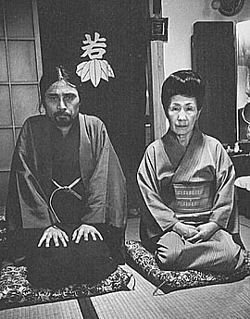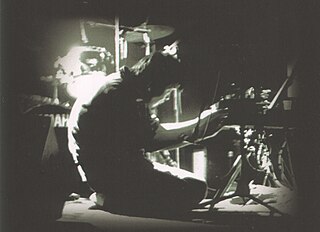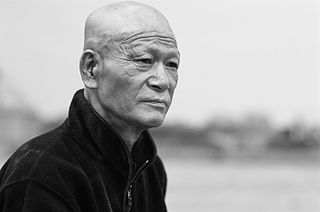Related Research Articles

Masatake Morita, also read as Shōma Morita, was the founder of Morita therapy, a branch of clinical psychology strongly influenced by Zen Buddhism. In his capacity as the head of psychiatry for a large Tokyo hospital, Morita began developing his methods while working with sufferers of shinkeishitsu, or anxiety disorders with a hypochondriac base.

Butoh is a form of Japanese dance theatre that encompasses a diverse range of activities, techniques and motivations for dance, performance, or movement. Following World War II, butoh arose in 1959 through collaborations between its two key founders, Tatsumi Hijikata and Kazuo Ohno. The art form is known to "resist fixity" and is difficult to define; notably, founder Hijikata Tatsumi viewed the formalisation of butoh with "distress". Common features of the art form include playful and grotesque imagery, taboo topics, and extreme or absurd environments. It is traditionally performed in white body makeup with slow hyper-controlled motion. However, with time butoh groups are increasingly being formed around the world, with their various aesthetic ideals and intentions.

Tatsumi Hijikata was a Japanese choreographer, and the founder of a genre of dance performance art called Butoh. By the late 1960s, he had begun to develop this dance form, which is highly choreographed with stylized gestures drawn from his childhood memories of his northern Japan home. It is this style which is most often associated with Butoh by Westerners.

Battle Royale II: Requiem is a 2003 Japanese dystopian action film directed by Kinji Fukasaku and Kenta Fukasaku, who co-wrote the screenplay with Norio Kida. It is the sequel to the 2000 film Battle Royale, which in turn was based on the 1999 novel of the same name by Koushun Takami. Unlike the first film, Requiem is an original story. It is set three years after the events of the previous film and follows Shuya Nanahara, who has now become an international terrorist intending to bring down the Japanese totalitarian government. As a result, another class of ninth graders is kidnapped and sent to eliminate Nanahara within a limited time period of 72 hours.

Kazuo Ohno was a Japanese dancer who became a guru and inspirational figure in the dance form known as Butoh. He is the author of several books on Butoh, including The Palace Soars through the Sky, Dessin, Words of Workshop, and Food for the Soul. The latter two were published in English as Kazuo Ohno's World: From Without & Within (2004).

Junichi Kakizaki is a Japanese artist, sculptor, floral artist, nature art artist, land art artist and environmental artist. He exhibits regularly both in Japan and internationally. Since 1992, he has mainly worked on scenography. He brought a floral design representation in area of contemporary art. His daughter, Memi, is a former member of Japanese idol group Hinatazaka46.
Ballet Philippines (BP) is a ballet company in the Philippines founded in 1969 by Alice Reyes with the support of Eddie Elejar and the Cultural Center of the Philippines. Proficient in both ballet and modern dance, the company synthesizes diverse dance and movement forms into distinctively Filipino contemporary expressions. These include classical ballet, avant-garde choreography, traditional and modern dance, martial arts, and aerial movements.

Sapporo is a city in Japan. It is the largest city north of Tokyo and the largest city in Hokkaido, the northernmost main island of the country. It ranks as the fifth most populous city in Japan. It is the capital city of Hokkaido Prefecture and Ishikari Subprefecture. Sapporo lies in the southwest of Hokkaido, within the alluvial fan of the Toyohira River, which is a tributary stream of the Ishikari. It is considered the cultural, economic, and political center of Hokkaido.

Eiko Otake and Takashi Koma Otake, generally known as Eiko & Koma, are a Japanese performance duo. Since 1972, Eiko & Koma have worked as co-artistic directors, choreographers, and performers, creating a unique theater of movement out of stillness, shape, light, sound, and time. For most of their multi-disciplinary works, Eiko & Koma also create their own sets and costumes, and they are usually the sole performers in their work. Neither of them studied traditional Japanese dance or theater forms and prefer to choreograph and perform only their own works. They do not bill their work as Butoh though Eiko & Koma cite Kazuo Ohno as their main inspiration.

Ikuro Takahashi is a Japanese drummer and percussionist based in Sapporo, also plays electronic and oscillators. He has been a central member of many groups from the Tokyo psychedelic underground from the early eighties. Some of the groups he has played with include Fushitsusha, High Rise, Kousokuya, Maher Shalal Hash Baz, Ché-SHIZU, Nagisa ni te, LSD March, Gu-N, and Akebonoizu, Tetsuya Umeda and Fumio Kosakai of Incapacitants. He has performed under the name Anoyondekigoto since 2000, a unit project with a Butoh dancer Yoko Muronoi(1959- 2017). He runs his own label Galleria Zarigania since 2007.

Atsushi Takenouchi is a Japanese Butoh dancer who performs various solo works as well as collaborations; such as "Enclosure" performed in conjunction with Brighton based arts company, Red Earth, on Hambledon Hill, Dorset.

Daishi Dance is a male Japanese DJ and record producer.
Koichi Tamano (玉野黄市) is one of the masters of the Japanese dance form Butoh. He performed individually or with his wife Hiroko Tamano and their performance group Harupin-Ha. He has also performed with other artists including Kitaro. They introduced the dance form to the west coast of America.

Simona Orinska is a Latvian butoh artist and a contemporary dancer, poet, director and choreographer. She is also a Dance Therapy and Dance Movement Therapy practitioner.
Ursula Endlicher is a New York City based Austrian multi-media artist who creates works in the fields of internet art, performance art and installation art.
Akira Kasai (1943) is a Japanese butoh dancer and choreographer, who despite being significantly younger than mentors Kazuo Ohno and Tatsumi Hijikata, is considered to be pioneers of the art form along with them. Kasai trained in other forms of dance, but turned to butoh in the 1960s when he met and began to work with these two men. He started his own studio in 1971 but closed it in 1979 to move and study Eurythmy in Germany. He did not dance professionally at the time and for years after his return to Japan in 1986 he stayed off the stage stating that he felt too disconnected from Japanese society to perform. He returned to professional dance in 1994, with the work Saraphita and revived his studio Tenshi kan, now influenced by Eurythmy and other dance principles. He has since performed, choreographed and taught in Asia, the Americas and Europe, but his choreography is sufficiently different from most other butoh that its authenticity has been questioned.

Japan competed in the 2017 Asian Winter Games in Sapporo and Obihiro, Japan from February 19 to 26. This marked the fourth time the country has played host to the Asian Winter Games. Japan competed in all eleven disciplines from five sports. Ice hockey player Go Tanaka was the country's flagbearer during the parade of nations at the opening ceremony.

Kō Murobushi was a Japanese dancer and choreographer who was a leading inheritor of Tatsumi Hijikata's original vision of Butoh.
Gallery MORYTA is a gallery located in Fukuoka, Japan. Established in 1991, its focus lies on contemporary art. Numerous exhibitions are held every year, with works by artists like Tatsuo Ikeda, Ryosuke Yasumoto, Season Lao and Aki Mitsugi. The gallery is a cultural hub, hosting events such as live music shows and artist' talks. The ART FAIR ASIA FUKUOKA, held yearly, is one of its initiatives. The gallery participates in fairs in both Japan and overseas.
Sayoko Onishi is a butoh dancer, choreographer and master from Japan, known for the development of the new butoh style, and the foundation of the International Butoh Academy in Palermo, Italy.